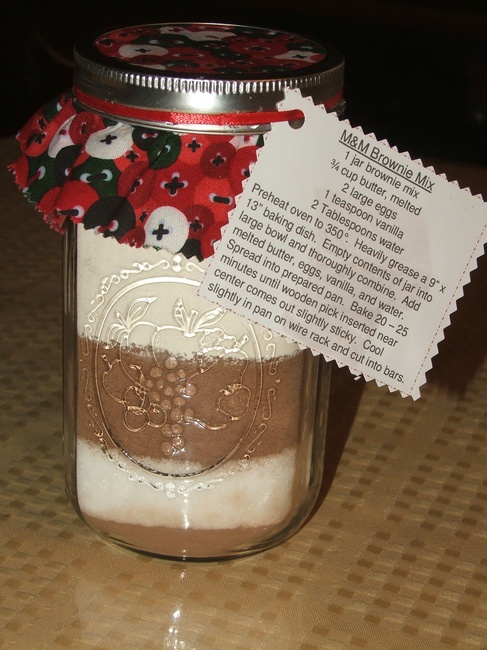Benchmark Fraction Brownie Mix

Materials
- 1 wide-mouthed, one-quart jar per student
- ¼ cup measuring scoop and knife for leveling in baking cocoa
- ¼ cup measuring scoop in granulated sugar (for adding)
- ½ cup measuring scoop and knife for leveling in Nestle NesQuick (for multiplying)
- ⅓ cup measuring scoop and knife for leveling in all-purpose flour (for multiplying)
- ¼ teaspoon in baking powder (for adding)
- ½ teaspoon in salt (for dividing)
- ¼ cup measuring scoop in M&M candies (for adding or multiplying)
- 1 cooking instructions tag for each student (print on cardstock, cut apart, hole-punch upper corner) [see downloadable document below materials list]
- 2 – 3 copies of the recipe for assembly (print on card stock, fold in half to display) [see downloadable document below materials list]
- 1 copy of “M&M Brownie Mix-in-a-Jar” worksheet per student [see downloadable document in Practice]
- 1 circle of fabric per student, 7-inch diameter (optional)
- 1 length of ribbon per student, 24′′ – 36′′ (optional)
- 1 copy of extended activity “Jar Filling Party” per student (optional) [see downloadable document in Extended Practice]
Preparation
Print, copy, cut, and collect materials. Set ingredients out in a row on a table (a table cloth will make clean-up easy), following the order in which they are listed. Place measuring scoops and spoons in the ingredients as listed in the materials section. Put out folded Assembly Recipes.
Opening Statements
“Today we will layer the dry ingredients for a brownie recipe into a jar to give as a gift or to use at home. The measuring scoop that is in each ingredient is not the exact amount that is needed for the recipe. You must decide how to use that measuring scoop to measure the proper amount into the jar. We’ll discuss a lot of ideas about fractions as you make those decisions. Then you will decorate the jar and add the cooking instructions tag. Lastly, we’ll complete some practice sheets to make sure you’ve got the concepts we explored here.”
Have everyone wash their hands, then give directions regarding where to start and where to find the recipe directions. Make sure that students know that the ingredients must be tapped down well after each addition of ingredients in order for them to all fit. Demonstrate with a jar that it is okay to ‘tap’ with pretty significant force without breaking the jar. Demonstrate the proper way to measure ingredients such as flour by leveling a scoopful with a knife so they can see.
Heads Up
Heads Up:
Even students with fairly high appraisal scores will find this activity
harder than you might imagine if they don’t have cooking experience. Don’t make any assumptions about students’
abilities.
Activity
As individual students go to each ingredient and while they are tapping, say things like:
- “You discovered that there is a quarter-cup scoop in the sugar, but the recipe calls for 1 cup of sugar. How will you measure 1 cup using ¼ cup?”
- “You are actually adding fractions when you measure that out. ¼ + ¼ + ¼ + ¼ = one whole. How many quarters are in one whole?”
- “How did you know how many times to use that measuring scoop?” Restate their answers for them in clear language, if needed.
- “What you’re doing there is actually (name the operation). Can you explain how I know that?”
- “Can you explain how to take ½ of a cup of NesQuick with a quarter-cup scoop?
- “What if you were making two jars? How many ⅓-cup scoops of flour would you need then?”
- “What would happen if you used that scoop (name an appropriate number) times instead? How much (name the ingredient) would that be?”
- “What if you needed half of the amount the ingredient calls for in the recipe? What would you do instead?”
Write example problems on the board as needed during the activity or as a wrap-up for the activity. Finish off the jars with the fabric circles (if desired) and tie cooking instructions on to the lid. Move onto the practice sheet as students finish their jars.
Practice
In order to answer the questions on the practice sheet, students should be picturing the fractions rather than following a ‘get a common denominator, add the numerators’-type procedure.
| Answers to practice questions: | |
| 1) Doubled recipe: ½ cup baking cocoa 2 cups granulated sugar 3 cups Nestle Nesquick 2 ⅔ cups all-purpose flour 1 teaspoon baking powder ½ teaspoon salt 2 cups M&M candies | 2) Tripled recipe: ¾ cup baking cocoa 3 cups granulated sugar 4 ½ cups Nestle Nesquick 4 cups all-purpose flour 1 ½ teaspoon baking powder ¾ teaspoon salt 3 cups M&M candies |
| 3) 1 ½ sticks of butter |
Extended Practice
Give students “Jar-Filling Party” practice sheet page one. These questions can all be answered without teaching a single procedure for adding or multiplying fractions. Help students to visualize combining the fractions, drawing sketches as needed to aid in this. You can extend further by adding the last two “Jar-Filling Party” pages (Challenge and Double Challenge).
Summary Discussion
Ask students to each write down two to three new things they learned from this experience. After everyone has written down their ideas, ask them to share one big “take away” with the class.